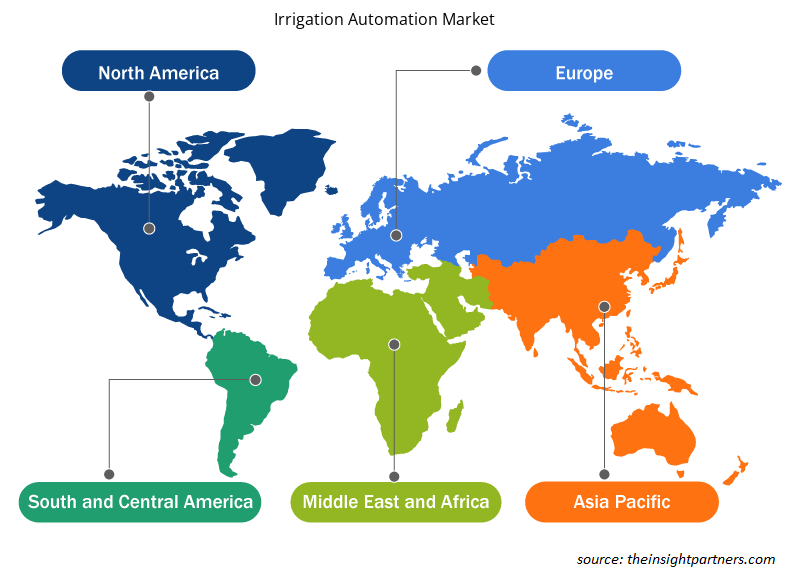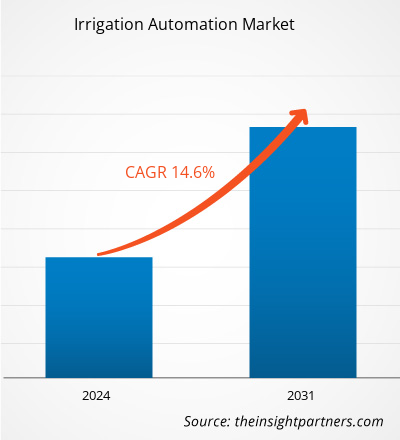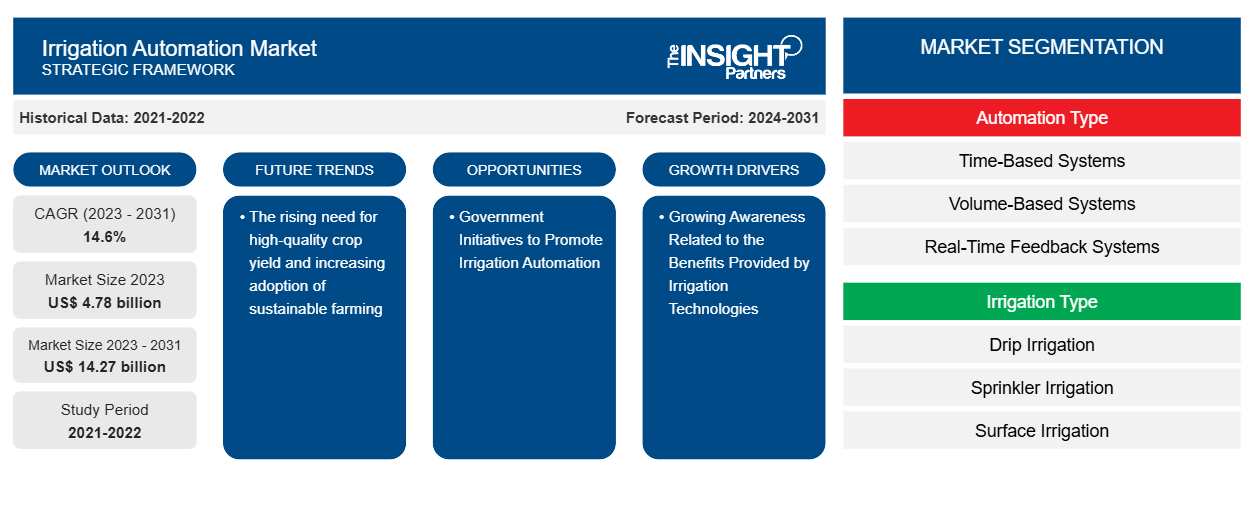Se proyecta que el tamaño del mercado de automatización del riego alcance los 14.270 millones de dólares en 2031, frente a los 4.780 millones de dólares en 2023. Se espera que el mercado registre una CAGR del 14,6 % entre 2023 y 2031. Es probable que la creciente necesidad de un rendimiento de cultivos de alta calidad y la creciente adopción de la agricultura sostenible sigan siendo una tendencia clave en el mercado de la automatización del riego.
Análisis del mercado de automatización del riego
El mercado de la automatización del riego está creciendo a un ritmo rápido debido a la creciente conciencia relacionada con los beneficios que brindan las tecnologías de riego y la aceptación de instrumentos y técnicas agrícolas precisas. El mercado se está expandiendo de manera constante, impulsado por la creciente demanda de tecnologías agrícolas inteligentes. Además, los avances tecnológicos y las iniciativas gubernamentales para promover la automatización del riego están brindando oportunidades lucrativas para el crecimiento del mercado.
Descripción general del mercado de automatización del riego
La automatización del riego utiliza instrumentos o equipos para operar varios sistemas de riego y alterar el flujo de agua de los muelles. La automatización del riego incluye la combinación de numerosos equipos , como sensores, válvulas, controladores, aspersores y otros, para construir un sistema automatizado que se utilice tanto para aplicaciones agrícolas como no agrícolas. Los importantes beneficios que ofrece la automatización del riego, como el ahorro de tiempo, la rentabilidad, la optimización de los recursos y otros, están impulsando el mercado.
Personalice este informe según sus necesidades
Obtendrá personalización en cualquier informe, sin cargo, incluidas partes de este informe o análisis a nivel de país, paquete de datos de Excel, así como también grandes ofertas y descuentos para empresas emergentes y universidades.
-
Obtenga las principales tendencias clave del mercado de este informe.Esta muestra GRATUITA incluirá análisis de datos, desde tendencias del mercado hasta estimaciones y pronósticos.
Factores impulsores y oportunidades del mercado de automatización del riego
La creciente conciencia sobre los beneficios que brindan las tecnologías de riego está impulsando el mercado
Los agricultores son cada vez más conscientes de las tecnologías de riego automatizado asociadas a los altos costos de mano de obra y electricidad. Las tecnologías de riego brindan beneficios significativos a los usuarios, como la conservación del agua, la automatización de procesos y el ahorro de costos, entre otros, que impulsan el mercado. Estos beneficios aumentan la conciencia entre los agricultores, lo que impulsa la adopción de tecnologías de riego. Estas tecnologías ayudan a los agricultores a disminuir el uso diario de electricidad, así como a reducir el tiempo y el esfuerzo dedicados al riego. Además, los agricultores pudieron reducir la cantidad de viajes a la granja mediante la automatización, lo que resultó en menores gastos de mano de obra. La instalación de un sistema de riego automatizado mejora la precisión agrícola al determinar el volumen exacto de agua y el tiempo de riego. Esta precisión reduce las pérdidas de cultivos para los agricultores y aumenta la productividad total.
Iniciativas gubernamentales para promover la automatización del riego: una oportunidad en el mercado de la automatización del riego
La mayoría de los agricultores de los países subdesarrollados emplean sistemas de riego convencionales (riego de superficie), que es un proceso que requiere mucho tiempo. Esto anima a los gobiernos de varias naciones a tomar iniciativas favorables para promover la automatización del riego, lo que se espera que cree oportunidades en el mercado. Muchos gobiernos de países en desarrollo como India, China, Brasil, Estados Unidos, Francia y otros países africanos ofrecen subvenciones para la compra de sistemas de goteo y aspersión con el fin de aumentar la eficiencia de sus sistemas de riego. Además, las políticas estrictas que fomentan el uso de sistemas de riego por aspersión y goteo ayudan a los agricultores a adoptar sistemas tecnológicamente desarrollados en sus explotaciones, como la adquisición y reinstalación de dispositivos de riego agrícola ( sistemas de aspersión y goteo). Estos factores están creando importantes oportunidades de crecimiento para el mercado durante el período de previsión.
Análisis de segmentación del informe de mercado de automatización del riego
Los segmentos clave que contribuyeron a la derivación del análisis del mercado de automatización del riego son el tipo de automatización, el tipo de riego, el componente, el sistema y el usuario final.
- Según el tipo de automatización, el mercado se divide en sistemas basados en tiempo, sistemas basados en volumen, sistemas de retroalimentación en tiempo real y sistemas de control de riego basados en computadora. El segmento de sistemas basados en tiempo tuvo una mayor participación de mercado en 2023.
- Según el tipo de riego, el mercado se divide en riego por goteo, riego por aspersión y riego de superficie. El segmento de riego por goteo tuvo una mayor participación de mercado en 2023.
- En términos de componentes, el mercado está segmentado en controladores, sensores, válvulas, aspersores y otros. El segmento de controladores tuvo una mayor participación de mercado en 2023.
- Según el sistema, el mercado de automatización del riego se divide en automático y semiautomático. El segmento automático tuvo una mayor participación de mercado en 2023.
- En términos de usos finales, el mercado se clasifica en agrícola y no agrícola. El segmento agrícola tuvo una mayor participación de mercado en 2023.
Análisis de la cuota de mercado de la automatización del riego por geografía
El alcance geográfico del informe del mercado de automatización del riego se divide principalmente en cinco regiones: América del Norte, Asia Pacífico, Europa, Medio Oriente y África, y América del Sur/América del Sur y Central.
En términos de ingresos, Asia Pacífico representó la mayor participación en el mercado de automatización de riego, debido a la presencia de vastas tierras agrícolas y al apoyo gubernamental favorable. Se prevé que el mercado se expanda en el futuro cercano, atribuido a los rápidos cambios en las condiciones climáticas y la creciente necesidad de reducir el desperdicio de residuos. Además, los avances tecnológicos y el desarrollo de sistemas de riego avanzados están impulsando el mercado durante el período de pronóstico.
Perspectivas regionales del mercado de automatización del riego
Los analistas de Insight Partners explicaron en detalle las tendencias y los factores regionales que influyen en el mercado de automatización de riego durante el período de pronóstico. Esta sección también analiza los segmentos y la geografía del mercado de automatización de riego en América del Norte, Europa, Asia Pacífico, Medio Oriente y África, y América del Sur y Central.

- Obtenga datos regionales específicos para el mercado de automatización del riego
Alcance del informe de mercado de automatización del riego
| Atributo del informe | Detalles |
|---|---|
| Tamaño del mercado en 2023 | 4.780 millones de dólares estadounidenses |
| Tamaño del mercado en 2031 | US$ 14.270 millones |
| CAGR global (2023 - 2031) | 14,6% |
| Datos históricos | 2021-2022 |
| Período de pronóstico | 2024-2031 |
| Segmentos cubiertos |
Por tipo de automatización
|
| Regiones y países cubiertos |
América del norte
|
| Líderes del mercado y perfiles de empresas clave |
|
Densidad de actores del mercado: comprensión de su impacto en la dinámica empresarial
El mercado de automatización de riego está creciendo rápidamente, impulsado por la creciente demanda de los usuarios finales debido a factores como la evolución de las preferencias de los consumidores, los avances tecnológicos y una mayor conciencia de los beneficios del producto. A medida que aumenta la demanda, las empresas amplían sus ofertas, innovan para satisfacer las necesidades de los consumidores y aprovechan las tendencias emergentes, lo que impulsa aún más el crecimiento del mercado.
La densidad de actores del mercado se refiere a la distribución de las empresas o firmas que operan dentro de un mercado o industria en particular. Indica cuántos competidores (actores del mercado) están presentes en un espacio de mercado determinado en relación con su tamaño o valor total de mercado.
Las principales empresas que operan en el mercado de automatización del riego son:
- Compañía: Galcon Ltd.
- Industrias Hunter Inc.
- Irritec SpA
- Sistemas de riego Jain Ltd.
- Corporación Lindsay
- Corporación de Irrigación Nelson
Descargo de responsabilidad : Las empresas enumeradas anteriormente no están clasificadas en ningún orden particular.

- Obtenga una descripción general de los principales actores clave del mercado de automatización del riego
Noticias y desarrollos recientes del mercado de automatización del riego
El mercado de automatización del riego se evalúa mediante la recopilación de datos cualitativos y cuantitativos posteriores a la investigación primaria y secundaria, que incluye publicaciones corporativas importantes, datos de asociaciones y bases de datos. A continuación, se incluye una lista de los avances en el mercado de automatización del riego y las estrategias:
- En marzo de 2024, Rubicon Water dará a conocer su último proyecto en la frontera entre Uzbekistán y Tayikistán. Este innovador proyecto, que cuenta con el apoyo de la Oficina de Cooperación Suiza y la Blue Peace Initiative, se centra en la distribución y medición transfronterizas para promover la colaboración en la gestión del agua transfronteriza. Además de mejorar la gestión del agua para riego, la tecnología de Rubicon desempeña un papel cada vez más crucial en la gestión de las aguas subterráneas, los programas de recarga y las iniciativas de caudal ambiental, contribuyendo a la preservación de recursos hídricos y ecosistemas vitales. (Fuente: Rubicon Water, comunicado de prensa, 2024)
Informe sobre el mercado de automatización del riego: cobertura y resultados
El informe “Tamaño y pronóstico del mercado de automatización del riego (2021-2031)” proporciona un análisis detallado del mercado que cubre las siguientes áreas:
- Tamaño del mercado y pronóstico a nivel global, regional y nacional para todos los segmentos clave del mercado cubiertos bajo el alcance
- Dinámica del mercado, como impulsores, restricciones y oportunidades clave
- Principales tendencias futuras
- Análisis detallado de las cinco fuerzas de Porter y PEST y FODA
- Análisis del mercado global y regional que cubre las tendencias clave del mercado, los principales actores, las regulaciones y los desarrollos recientes del mercado.
- Análisis del panorama de la industria y de la competencia que abarca la concentración del mercado, el análisis de mapas de calor, los actores destacados y los desarrollos recientes
- Perfiles detallados de empresas
- Análisis histórico (2 años), año base, pronóstico (7 años) con CAGR
- Análisis PEST y FODA
- Tamaño del mercado, valor/volumen: global, regional y nacional
- Industria y panorama competitivo
- Conjunto de datos de Excel
Informes recientes
Testimonios
Razón para comprar
- Toma de decisiones informada
- Comprensión de la dinámica del mercado
- Análisis competitivo
- Información sobre clientes
- Pronósticos del mercado
- Mitigación de riesgos
- Planificación estratégica
- Justificación de la inversión
- Identificación de mercados emergentes
- Mejora de las estrategias de marketing
- Impulso de la eficiencia operativa
- Alineación con las tendencias regulatorias























 Obtenga una muestra gratuita para - Mercado de automatización del riego
Obtenga una muestra gratuita para - Mercado de automatización del riego